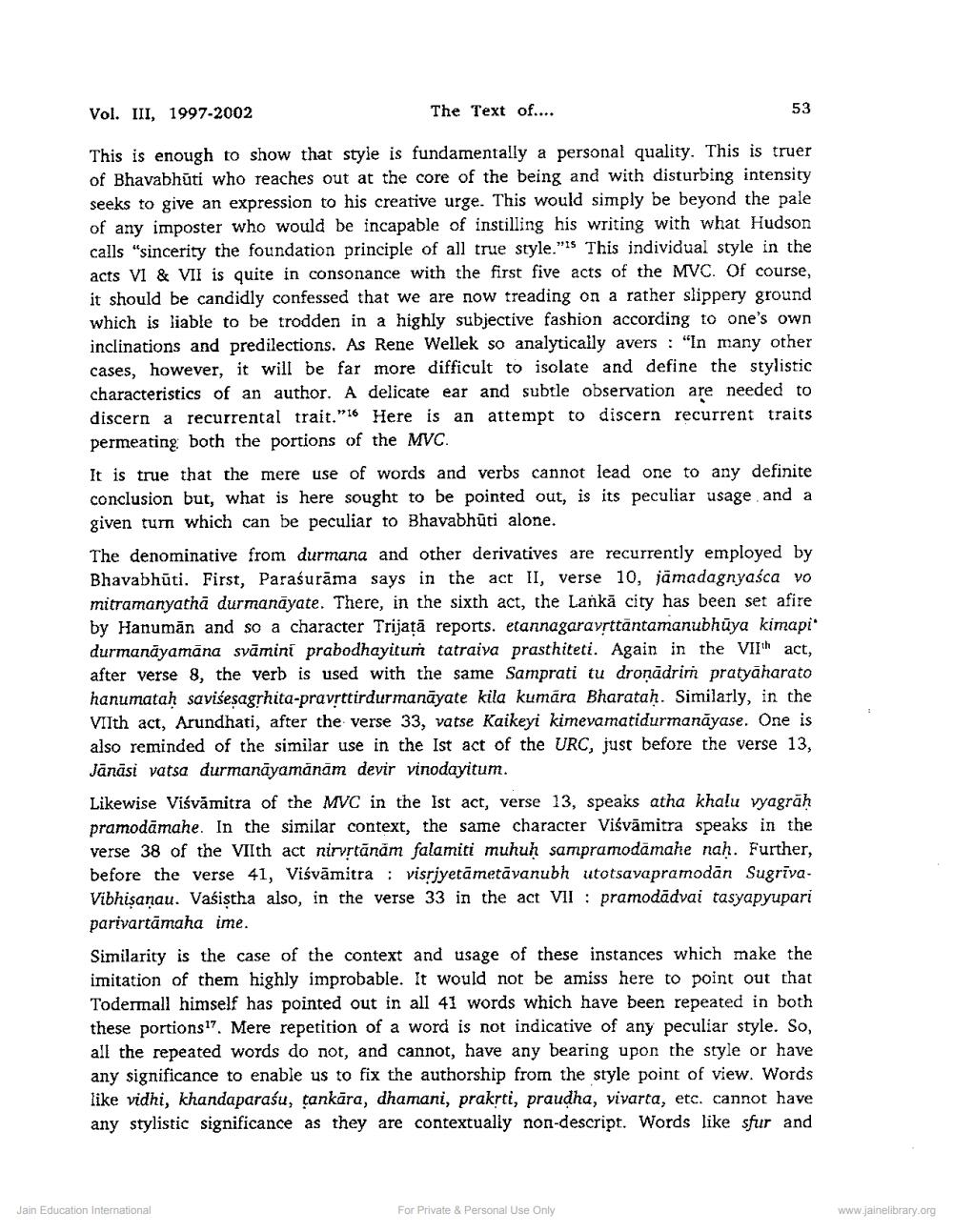Book Title: Text of Mahavircarita of Bhavbhuti Author(s): Vijay Pandya Publisher: Z_Nirgrantha_1_022701.pdf and Nirgrantha_2_022702.pdf and Nirgrantha_3_022703.pdf View full book textPage 6
________________ Vol. III, 1997-2002 The Text of.... 53 This is enough to show that style is fundamentally a personal quality. This is truer of Bhavabhūti who reaches out at the core of the being and with disturbing intensity seeks to give an expression to his creative urge. This would simply be beyond the pale of any imposter who would be incapable of instilling his writing with what Hudson calls "sincerity the foundation principle of all true style." This individual style in the acts VI & VII is quite in consonance with the first five acts of the MVC. Of course, it should be candidly confessed that we are now treading on a rather slippery ground which is liable to be trodden in a highly subjective fashion according to one's own inclinations and predilections. As Rene Wellek so analytically avers : "In many other cases, however, it will be far more difficult to isolate and define the stylistic characteristics of an author. A delicate ear and subtle observation are needed to discern a recurrental trait."16 Here is an attempt to discern recurrent traits permeating both the portions of the MVC. It is true that the mere use of words and verbs cannot lead one to any definite conclusion but, what is here sought to be pointed out, is its peculiar usage and a given turn which can be peculiar to Bhavabhūti alone. The denominative from durmana and other derivatives are recurrently employed by Bhavabhūti. First, Parasurāma says in the act II, verse 10, jämadagnyaśca vo mitramanyathā durmanäyate. There, in the sixth act, the Lankā city has been set afire by Hanumān and so a character Trijatā reports. etannagaravsttantamanubhūya kimapi durmanāyamāna svāmini prabodhayitum tatraiva prasthiteti. Again in the VIIth act, after verse 8, the verb is used with the same Samprati tu droņādrim pratyaharato hanumataḥ savisesagrhita-pravsttirdurmanāyate kila kumāra Bharatah. Similarly, in the VIIth act, Arundhati, after the verse 33, vatse Kaikeyi kimevamatidurmanāyase. One is also reminded of the similar use in the Ist act of the URC, just before the verse 13, Jānāsi vatsa durmanāyamanām devir vinodayitum. Likewise Viśvamitra of the MVC in the Ist act, verse 13, speaks atha khalu vyagrah pramodāmahe. In the similar context, the same character Viśvāmitra speaks in the verse 38 of the VIIth act nirvstānam falamiti muhuh sampramodāmahe nah. Further, before the verse 41, Viśvāmitra : visriyetā metāvanubh utotsavapramodān SugrīvaVibhisanau. Vaśiştha also, in the verse 33 in the act VII : pramodădvai tasyapyupari parivartāmaha ime. Similarity is the case of the context and usage of these instances which make the imitation of them highly improbable. It would not be amiss here to point out that Todermall himself has pointed out in all 41 words which have been repeated in both these portions?. Mere repetition of a word is not indicative of any peculiar style. So, all the repeated words do not, and cannot, have any bearing upon the style or have any significance to enable us to fix the authorship from the style point of view. Words like vidhi, khandaparasu, tankāra, dhamani, prakrti, praudha, vivarta, etc. cannot have any stylistic significance as they are contextually non-descript. Words like sfur and Jain Education International For Private & Personal Use Only www.jainelibrary.orgPage Navigation
1 ... 4 5 6 7 8 9
